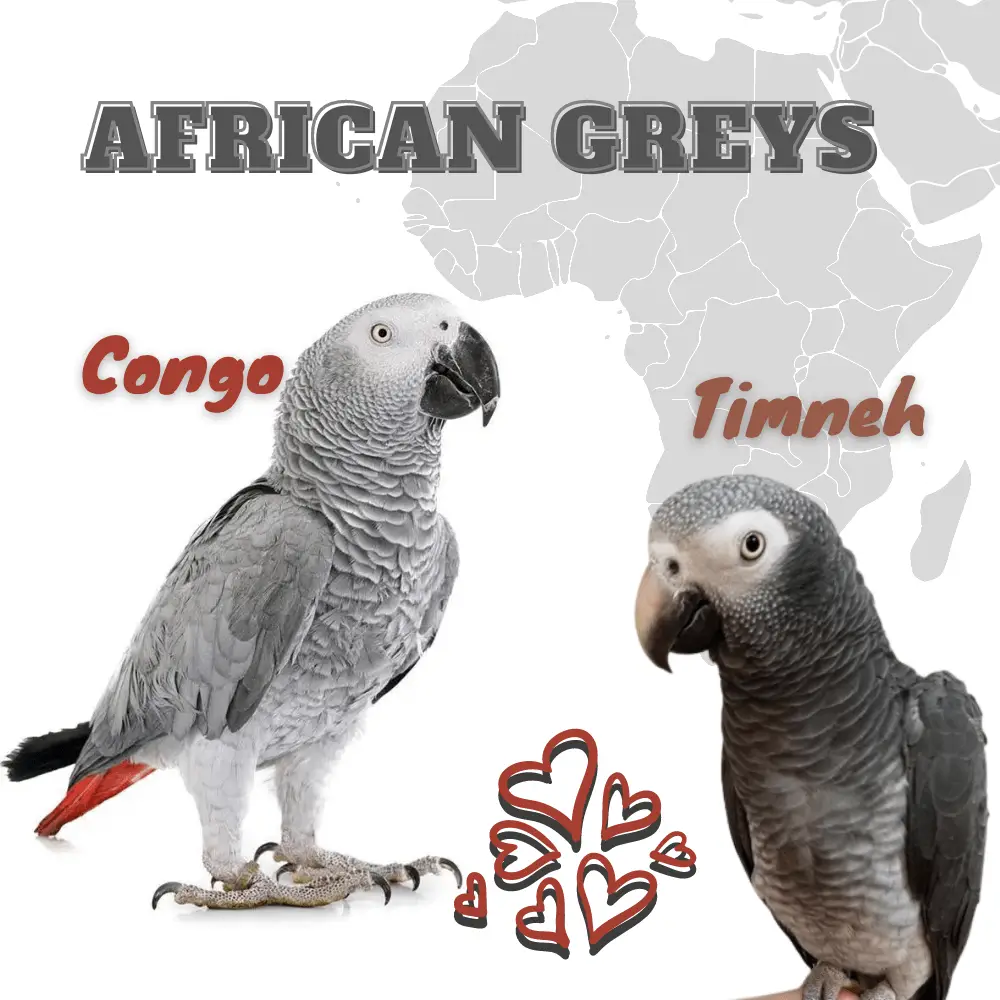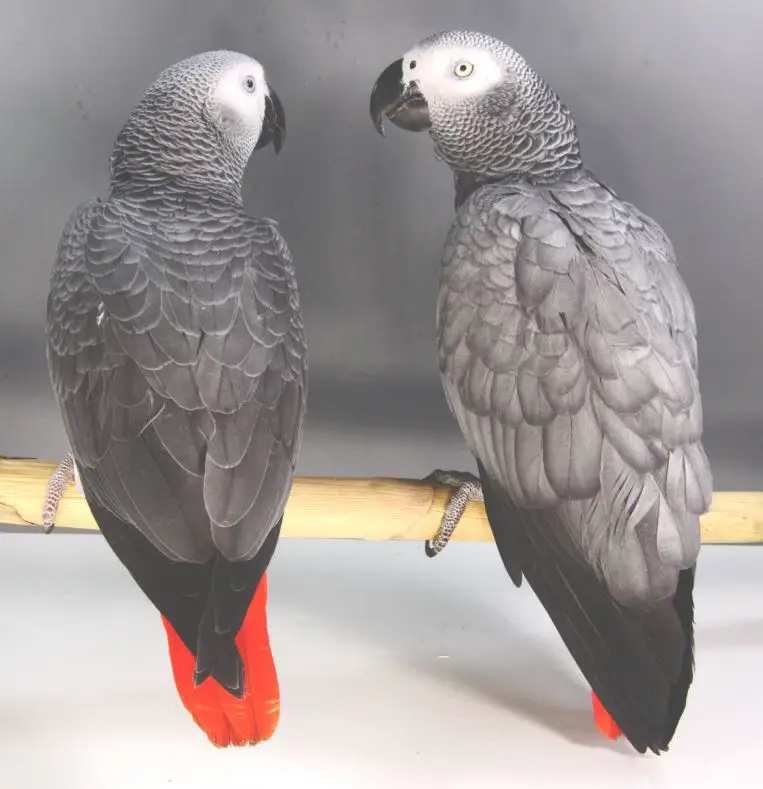
The African Greys is a parrot that also bears the name of Grey of Gabon and Grey of Congo. However, we hear it more often called Grey of Gabon.
The feathers of the African grey are ash-gray with several shades and its tail is a bright red. Live in groups of between 100 and 200 individuals.
It measures 35 to 40cm and its weight is around 400 to 500 grams. Its body temperature is 41 degrees C, which is why it lives in warm regions.
The African grey has few predators, the most harmful for him is the man. This parrot is able to imitate sounds and voices with great precision. It is a very intelligent talking bird too.
African Grey Species
Psittacus erithacus Erithacus: Commonly known as Congo, Jaco, or Gabon Grey. It is about 36 cm long, and its weight is 450 to 600 grams. Ash gray plumage, bright red tail. Equatorial Africa.
Psittacus erithacus princeps: Also called Ghana Grey, West African Grey, or Boyd Alexander. Looks a lot like the Congo, but a bit smaller.
Psittacus erithacus timneh: African Grey Timneh. 23 cm long, 250 to 350 grams. Dark charcoal gray plumage, maroon red tail. The upper mandible of the beak is pinkish beige.
Much smaller than Congo or Ghana. Western Côte d’Ivoire, Sierra Leone, Liberia, and Guinea. Less sullen temperament than Congo or Ghana. Less fearful and more rebellious. More likely to do silly things to get attention and have fun.
African Grey Habitat
The African grey lives in the tropical forest between 15 and 25 meters from the ground. He is a very good climber. When it comes to feeding and drinking on the ground, it does so in groups.
African Grey in the wild
The African greys is surely one of the most gregarious species in the world of parrots. In nature, it lives in bands of 100 to 200 (and sometimes more) individuals and remains in groups even during the breeding season.
African Grey flies above trees, sometimes reaching a height of 700 meters due to the density of the rainforest.
African Grey Health
The African Greys produce a fine powder to maintain its plumage. Good bird powder is a sign of good health. In the absence of this powder, the bird has a physiological problem.
African Grey Breeding
One of the highest-bred parrots in captivity and one of the most popular with amateurs, mainly because of its calm temperament, its intelligence, its remarkable ability to perfectly reproduce sounds.
African Grey Personality
Without solid socialization, anything unfamiliar to the bird automatically falls into the first category. This skepticism is normal in African greys. It is frightened by novelty and this, in all facets of its life ( humans, food, toys, objects, etc… ).
But do not be discouraged, after a while, curiosity overcomes its apprehensions. Above all, do not force it, it will take the time it takes. Gray can only accept newness very slowly… drop by drop.
the African grays is a very affectionate bird. It is in early childhood, when the African grey is still very naive, clingy, and unsuspecting, that it must be handled and given safe adventures.
After this stage, the gray becomes much more selective about what it is willing to accept from humans. Lack of socialization in early childhood is the most common cause of behavioral problems in adult parrots.
African Grey Behavior
African greys have great sensitivity with humans, he loves them and sympathizes with them a lot. He feels our deepest emotions, moods, moods, energies, and these are reflected in his behaviors.
The African grey is more thoughtful, wary, and therefore more fearful than other parrot species. It seems to classify any human or object around it into two categories:
Dangerous.
Possibly dangerous.
Normal and harmless.
African Grey As pet

The African Greys can in no way trust or respect anyone who has violent and aggressive reactions, both in voice and in gestures.
Due in large part to its sensitive nature and its high intelligence, the African grey can react very negatively to the awkwardness of an educator as well as during the training process.
You should never force a gray to do what he does not want, he could even develop phobic behavior. Therefore, it is necessary to train him at an early age about the means of communication and not to bite.
Grays only respond well to positive reinforcement. Raising a gray should be more like raising a child than raising a pet
Gray emits an impressive growl when frightened.
African grey parrot is a bird that only feels good if it feels safe and understands its environment well. We must always inform the grey of our intentions before handling or caressing them. This will make him more receptive. You should never surprise an African Greys.
The grey parrot needs to feel accepted and to be a full member of its social group (the human family) because it is a very social parrot. For his psychological and physiological balance, he needs a companion of his own kind. It’s not a whim… it’s a need.
He weaves a very strong bond with his loving partner ( bird or human ) and is totally devoted to him. He may favor his favorite human to the point of excluding all other family members. Again, good socialization can help avoid this kind of situation.
African Grey Diet
African greys feed on seeds, nuts, peanuts, bananas, corn, carrots, and also insects.
In nature, the african grey parrot diet is rich in vegetable fat, protein, and vitamin A. It is fond of palm nuts ( very rich in fat and vitamin A ), coffee tree seeds, and palm fruits ( Elaeis guinensis ). His digestive system is perfectly adapted to this kind of diet.
African Grey Baby
Immature birds ( less than a year old) have a dark grey, almost black eye irises. After a year, the iris turns pale and becomes pale gray, then takes on its final color. A mature bird has a pale or maize yellow iris.
African Grey Male And Female

It is almost impossible to tell the difference between males and females unless you do a DNA test or an endoscopy. The male chooses his mate and stays with her for life.
African Grey Male
The male parrot is sexually mature from the age of 2-3 years.
African Grey Female
The female African grey parrot does not reproduce before the age of 7 years. After breeding, she lays 3-4 eggs and the incubation lasts 30 days. The young remain in the nest for 80 days and are weaned 40-50 days later.
African Grey lifespan
The life expectancy of the African greys is 50 to 60 years.




















